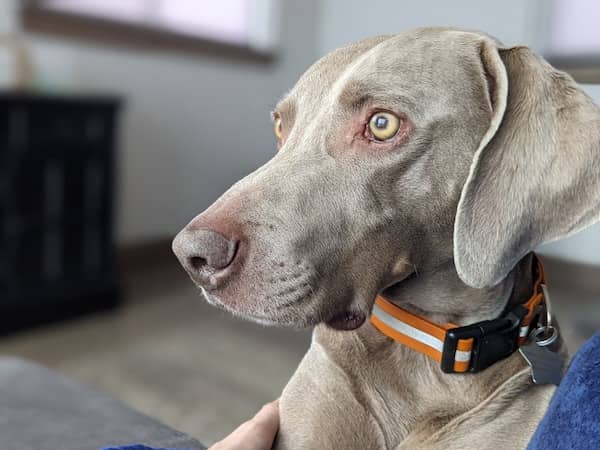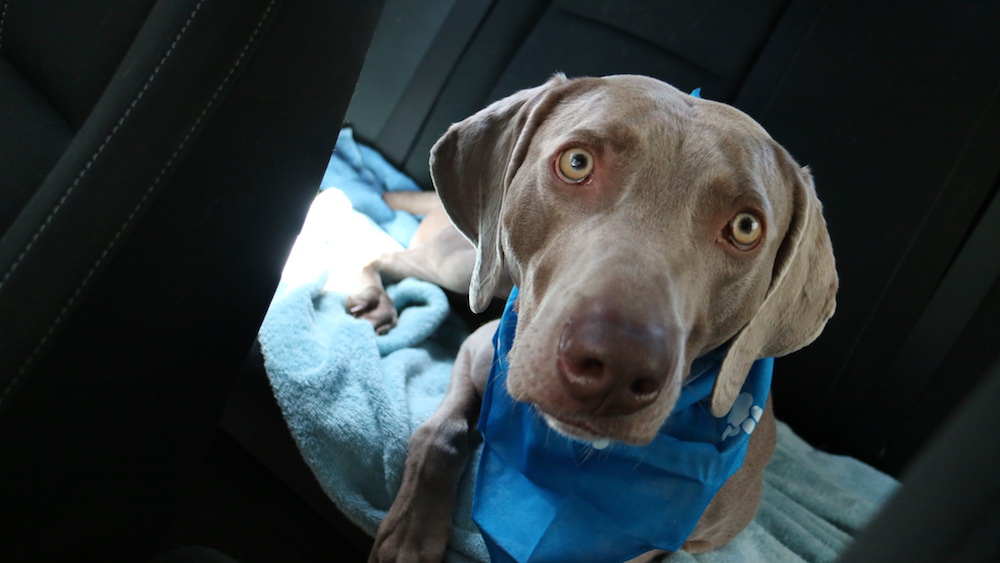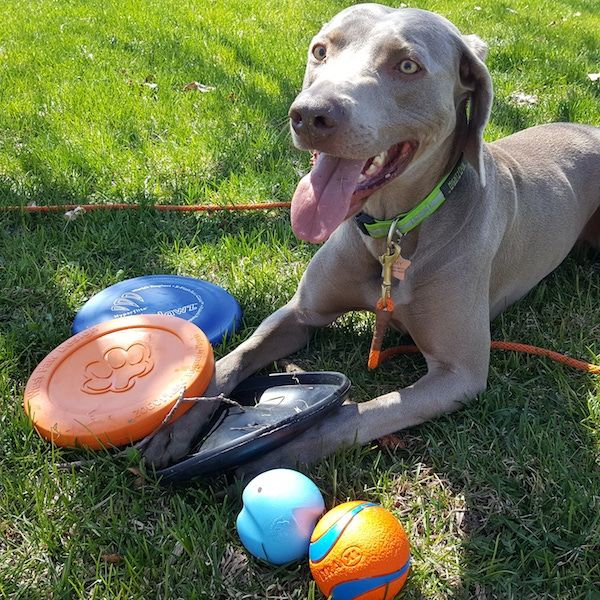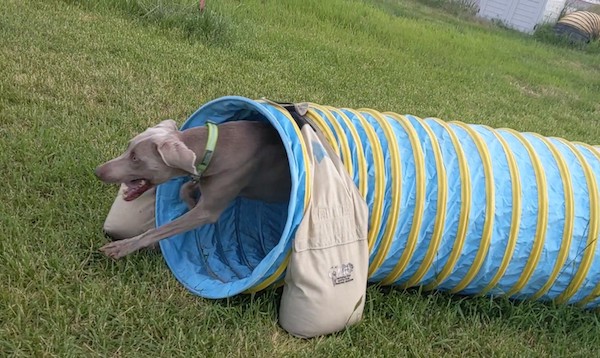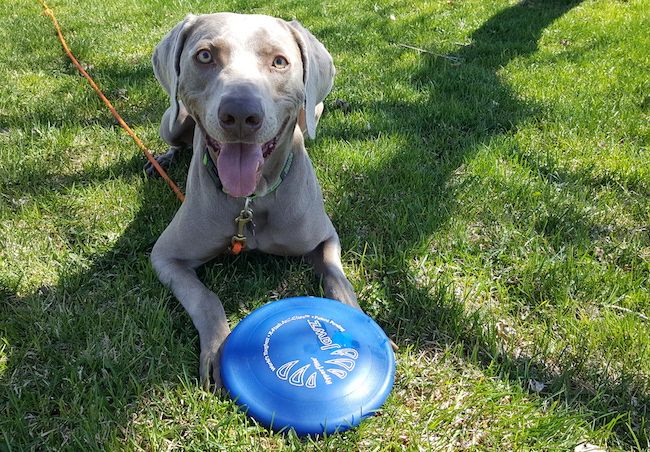My 5-year-old dog has developed some strong noise phobias in agility.
This article is about my personal experience and the very difficult decision to retire my dog from agility, at least temporarily.
This does not mean there is no hope for your fearful agility dog! There are a lot of resources available to help, and I will list out some suggestions you can certainly try.
This is a long article, so feel free to click below to jump to the section that interests you.
IN THIS ARTICLE:
My dog’s noise phobias in agility
Remy is a weimaraner and we started agility classes when he was 2.5 years old.
He LOVED agility for the first year and a half or so! We had three successful NADAC trials where he had a great time and ran confidently! I took that time for granted and I’m so glad I have those memories.
Then, he slowly became fearful of sounds in the indoor agility arenas and our practice barn.
We live in Montana and so we practice agility indoors most of the year due to our long winters.
Remy’s fears in agility started out as a mild fear of the wind against the metal barn doors where we would practice. He would jump and get distracted for a few seconds.
Unfortunately, it’s often windy here, but even a gentle wind can make those barn walls creak and bang. I will say, it is a creepy sound. Like an old, creaking ship. Or a haunted house.
Dog’s noise phobias in agility arenas
My dog Remy’s fears progressed to additional sounds in the agility environment such as:
- rain hitting the metal roof of the agility arena
- snow and ice sliding off the arena’s roof (this can be very loud!)
- people opening and shutting doors
- people moving agility equipment around
- the sound of dogs running through a tunnel obstacle
- flocks of pigeons flapping their wings in the building
He became fearful not just at our local facility but in other agility arenas we traveled to, as well. I tried three facilities in addition to our regular location. He was scared at all of them.
My dog’s fear of people in agility
My dog even became fearful of people at agility.
If you know my happy-go-lucky dog, you know it’s not normal for him to be afraid of people! It’s just that he was feeling so on edge that he was constantly on the lookout for anything and anyone suspicious.
I think of how I can feel scared while walking or running alone in certain areas after dark, which I rarely do. In these situations, I’m extra alert, and every little thing can seem scary.
The difference is I am aware that I’m generally safe, even in the dark. I know my mind can play tricks on me. Remy does not understand that he is safe at agility.
Examples of people who can scare my dog in agility:
- the judge
- the leash runner
- ring crew
- the people doing the timing
- any person out of the ring carrying something “different,” like a box
- men who are straight faced and not “animated”
My dog has unfortunately become fearful of the entire agility atmosphere, and it’s not fair to make him do a sport that causes him this much stress.
Signs of a fearful dog in agility
Sometimes the first signs of fear in dogs are very subtle. And keep in mind a little nervousness can be totally normal and healthy.
For example, I love running marathons, but of course I’m always stressed and anxious at the start of a race. This doesn’t mean I should not participate in marathons. The anxiety and excitement is normal.
Agility classes, and going to trials, can be exciting but also stressful for even the most confident dogs.
So don’t be too concerned if your dog is showing some mild stress. Just be aware of it.
Here are some signs a dog might be stressed or fearful in agility:
Mild signs of anxiety in agility dogs:
- Licking their lips
- Yawning when not tired
- Ears back
- Sniffing the ground excessively
- Eating dirt excessively
- Not able to focus on the handler
- Not interested in food or toys when they normally would be
- Taking/biting food or toys extra hard for that particular dog
- Tail tucked
- Mild trembling
- Looking around a lot
- Startles easily
- Whining a lot in the crate when they normally wouldn’t
- Hyperactivity, such as getting the “zoomies” in the ring
- Biting at the leash or nipping at the handler while running
- Barking at the handler while running the course
- Raised hackles
- Panting when they’re not hot
Again, if your dog is showing one or two of these signs or even several, it does not necessarily mean you have a problem.
Agility is an exciting atmosphere and it’s normal for dogs to experience a little stress and excitement.
Stronger signs of anxiety or fear in agility dogs:
Definitely take some time to step back and re-evaluate if you notice these signs in your dog. I strongly suggest getting help from a trainer or behaviorist you trust.
- Dog’s whole body appears tense
- Whole body held low to the ground
- Head held low (spine might be curved up)
- Dog is pulling towards the car or his crate for safety
- Barking or growling at other dogs or at people
- Obvious trembling/shaking
- Eyes are wide or completely black
- Glancing at people or dogs nervously
- No interest in high-valued food
- No interest in high-valued toys
- No interest in people he normally loves
- Ignores other dogs when he normally loves dogs
- Inability to perform agility obstacles he knows
- Tries to leave the agility ring
- Won’t come when called when he normally would
- Does not want to come out of the car or out of his crate
- Doesn’t want to get in the car if he knows you’re going to agility
- Does not want to enter the agility facility
- Can’t hold a startline stay when he normally would
- You just feel it in your gut your dog is not enjoying agility
- You feel guilty “making” your dog do agility
I’m sad to say my dog has shown ALL of these signs except for growling and barking, and I should’ve allowed him to retire from agility much sooner.
Other common fears for agility dogs
It’s not just noises that can scare some dogs in agility.
Other sources of fear for dogs in agility could be:
- Certain obstacles such as the “teeter” or the “A-frame”
- Dealing with other dogs barking or running
- Strangers
- Crowds
- Lots of other dogs in a tight area
- The judge or ring crew
- Loudspeakers
- People cheering or clapping
- Horses
- It could be anything really!
If your dog is showing fears of anything at all in agility, some of the resources I will share might help you. I also suggest reaching out to a trainer or behaviorist you trust.
Dog’s noise phobias outside of agility
The good news for my particular dog is that he is not overly fearful in general, outside of agility. Yes, he’s scared of thunder and fireworks, but that is true for a large percentage of dogs.
He startles easily in general and is suspicious of new things, but not overly fearful like he is in agility.
For example, it can be VERY windy while we’re outside going for a walk and he’s fine, even when trash or random objects are blowing around. Or if tree branches are making creaking sounds.
He’s also not startled by loud noises while we’re out for walks such as construction workers making all sorts of loud, pounding sounds.
My dog even goes hunting occasionally and has no fear at all of gunfire!
But some dogs might be just as fearful outside of agility as they are in agility.
Mistakes I made with my sound phobic agility dog
Looking back, the biggest mistake I made with my agility dog was to try to “work through” the problem. Meaning, I would try to ignore his fears as to not make a big deal out of it.
I would use high-valued treats like hot dogs or a squeaky toy to distract him, and this worked for several months. He would show signs of fear but they were fairly mild and he would take the hot dogs or the squeaky toy I had and be able to function.
Outside of agility, my dog is absolutely NUTS about food and toys, to the point where he will do almost anything for a toy and even get possessive of the toy. So this is why he was initially able to overcome his fears in order to get the toy or food.
All of the agility instructors and experienced agility handlers I knew encouraged me to “keep trying” and to keep using high-valued toys to basically bribe my dog. Make it fun and he’ll get better eventually, everyone seemed to hope.
I’m grateful for their support in trying to help Remy through his fears. I didn’t know of anything better to try, so this is what I did.
If he got distracted and started excessively sniffing or trying to leave the ring, I would run in the opposite direction, yelling “Woooo! Yeah, Remy!” And I would squeak a toy. Then he would come running and would re-engage with me.
But eventually, that no longer worked, either.
Dog tries to leave agility
At agility practice, my dog would run to the door of the arena or barn and try to get out. One time, when it was just Remy and I practicing, he did manage to get out of the barn, and he bolted across the fairgrounds in flight mode.
At trials, he would run to the ring gates, wanting to get out of there ASAP. I’m thankful it never occurred to him to simply leap over the gates.
Do not scold or correct a fearful dog
I’m glad that I never corrected my dog or scolded my dog for being afraid.
For example, I never told him he was bad for trying to pull me out of the building. I never jerked on the leash or told him “no” for startling over the wind. I didn’t even scold him for eating dirt or horse poop on the ground.
I DID, however, pull and drag him into the arena several times or into the ring when it was our turn. I do not recommend this, and I shouldn’t have done so. I was not putting my dog first. I was decreasing his trust in me by forcing him to do agility.
My dog should be able to trust me. He should not be forced to do a sport that scares him. I should’ve left class when he was scared and scratched from competition when he told me “no.”
So I’ve finally listened and will no longer make him do agility.
If your dog is showing some signs of fear in agility, here are some ideas you can try:
How to help a fearful agility dog
1. Switch agility locations
Try agility in a completely different environment and see if you notice a difference. If you’re lucky to have the space at home, you could make or buy your own equipment.
Perhaps there is an outdoor area you can practice in if your dog is normally afraid of the indoor environment. My dog is much more relaxed outside, so we will try doing some agility for fun during the summer and see how he does.
If it’s other dogs and people around that scare your dog, then perhaps you could rent a space to practice on your own or with a private instructor.
2. Consult with a professional trainer or behaviorist
If you’re having any trouble with your dog, it’s a good idea to consult with a professional trainer or dog behaviorist sooner rather than later.
Start with your agility instructor for some ideas. But if that person is not experienced in actual dog behavior, then find someone who trains dogs professionally.
The good news is there are a lot of dog trainers you can consult online these days, so you have resources available even if you live in a rural area.
The trainer or behaviorist will likely want to use a desensitization approach with your dog’s fears, along with counter conditioning.
3. Desensitization and counter conditioning
A professional trainer will be able to help you combine a training plan using a combination of desensitization and counter conditioning.
Desensitization for a fearful agility dog
Desensitization means you expose your dog to very low levels of their “trigger” so the dog does not react at all. Then, expose the dog to more intense levels of the trigger very gradually over time. It’s a game of details and patience. I recommend keeping notes.
If the dog shows even mild signs of fear, then you’ve done too much and need to take a step back.
I made this mistake with Remy. I kept exposing him to too much stimulus by bringing him into the arena when he was already scared. I should’ve just spent time with him in the car, parked 25 yards from the arena.
Counter conditioning
Counter conditioning means that you gradually work to change a dog’s emotional response to her trigger over time.
To do this, give high-valued treats to your dog around low levels of her trigger, low enough so you don’t trigger a reaction. When you move away from the trigger, stop giving the treats. You want your dog to eventually think, “Wait, I like this loud sound! I get hot dogs!”
Again, the mistake I made was giving the high-valued treats or toys too late, once my dog was already scared. If your dog is showing any reaction to her trigger, then you’ve gone too far.
Sometimes you have to break this into ridiculously small steps. For example, feeding your dog pieces of cheese or hot dogs in your car, 25 yards away from the agility arena. Or, feeding cheese while you walk around the outside of the building.
It’s certainly a very slow process that requires a lot of patience and is best done with a professional trainer.
Remember, “It takes as long as it takes.” That’s a quote from hunting dog trainer, Rick Smith. It’s a process. This might mean months or a year, not days or weeks.
You might decide it’s better to just retire your dog from agility or to take a few months off and re-group, as I’m doing. This is totally fine!
4. Rule out pain or a medical problem
Dogs are good at hiding their pain. It’s possible your dog is in pain and that is the reason she does not want to do agility.
It’s always a good idea to have your dog checked by a vet for any sort of orthopedic problem. It’s also a good idea to run bloo work if you haven’t done so in over a year. I had Remy checked by our vet and he seems healthy and his bloodwork was normal.
5. Could a thyroid condition cause a dog’s fears?
One of our very experienced agility instructors suggested I rule out a thyroid problem with Remy.
One of her past agility dogs suddenly developed similar fears and reactions in agility and it turned out that this particular dog had a thyroid problem.
Putting the dog on the right medication helped her feel better physically and all of her strange behavioral issues related to fear and aggression went away.
In my dog’s case, all of his bloodwork and thyroid testing came back normal, but I’m glad I ruled it out.
6. Anxiety medication for your fearful agility dog
There is a stigma about giving your dog anxiety medication but it is worth considering and weighing the pros and cons.
Though it’s not talked about, a lot of dogs do take medications such as prozac in order to cope with anxiety in their lives. Some of these dogs compete in performance sports like agility.
With our vet’s support, I briefly considered putting my dog on prozac to help him cope with his fears and anxiety in agility.
Behavioral meds are not bad, and I’m glad we have them as an option. But ultimately, I decided that if my dog needs to take medication in order to enjoy a sport, then we do not need that sport in our lives.
See my post: medications for dogs during fireworks
Other resources for noise phobic agility dog
Cog Dog Radio Podcast – Sarah Stremming is a dog trainer who focuses on behavior in sport dogs. I’ve listened to most of her podcasts as most are related to agility. There is one specifically on fearful dogs that is worth a listen. She also offers consulting sessions both in person or over the phone/video.
Book: Control Unleashed – This book lists out dozens of games you can use to help your fearful dog feel more comfortable in agility. It is a slow process but generally does work.
Books: Cautious Canine and Feisty Fido: These books are not specific to agility but they will help you gain a clear understanding of counter-conditioning and desensitization.
Final thoughts on fearful agility dogs
Most people will downplay your dog’s fears. People don’t know your dog like you do, so they may not be able to recognize how fearful he truly is. While trying to be encouraging, they will likely be asking you to push your dog too far. You know your dog best, and you have to be the best advocate for your own dog.
Most of us tend to push our fearful dogs too quickly. Be patient and take a few steps back. There is no time restraint for helping your fearful dog. It takes as long as it takes.
If you are dealing with a fearful dog in agility or any sport, I hope you’ll share your example in the comments below! It does help others to know they are not alone.
-Lindsay
Related articles:
Lindsay Stordahl is the founder of That Mutt. She writes about dog training, dog exercise and feeding a healthy raw diet.
